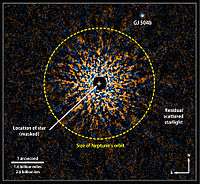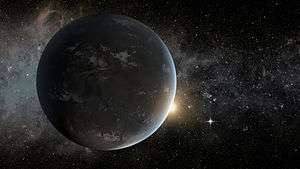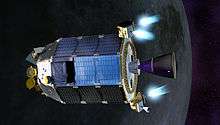Gliese 504 b
| Exoplanet | List of exoplanets | |
|---|---|---|
 | ||
| Parent star | ||
| Star | 59 Virginis (GJ 504) | |
| Constellation | Virgo | |
| Right ascension | (α) | 13h 16m 47.0s |
| Declination | (δ) | +09° 25′ 27″ |
| Apparent magnitude | (mV) | 5.22 |
| Distance | 57.27 ± 0.26 ly (17.56 ± 0.08 pc) | |
| Spectral type | G0V | |
| Mass | (m) | 1.22 ± 0.08 M☉ |
| Temperature | (T) | 6234 ± 25 K |
| Age | 0.160+.35 −.06 Gyr | |
| Observed separation Observation epoch 2012 Apr 12 | ||
| Angular separation | (ρ) | 2487 ± 8 mas |
| Position angle | (θ) | 326.54 ± 0.18° |
| Projected separation | (d) | 43.5 AU |
| Physical characteristics | ||
| Mass | (m) | 4.0+4.5 −1 MJ |
| Surface gravity | (g) | 3.9 ± 0.2 g |
| Temperature | (T) | 510 K (237 °C; 458 °F) |
| Discovery information | ||
| Discovery date | 2013 | |
| Discoverer(s) | Kuzuhara et al. | |
| Discovery method | Direct imaging | |
| Discovery site | Subaru Telescope | |
| Discovery status | Confirmed | |
| Other designations | ||
| 59 Vir b | ||
| Database references | ||
| Extrasolar Planets Encyclopaedia | data | |
| SIMBAD | data | |
| Exoplanet Archive | data | |
| Open Exoplanet Catalogue | data | |
Gliese 504 b (often shortened to GJ 504 b) is a Jovian planet in the system of the young solar analog 59 Virginis (GJ 504),[note 1] discovered by direct imaging using HiCiao instrument and AO188 adaptive optics system on the 8.2-meter Subaru Telescope of Mauna Kea Observatory, Hawaii by Kuzuhara et al.[1] Visually, GJ 504 b would have a magenta color.
History of observation
The discovery images were taken in 2011 and common proper motion was confirmed in 2012 as part of the Strategic Exploration of Exoplanets and Disks with Subaru (SEEDS) survey. The SEEDS survey aims to detect and characterize giant planets and circumstellar disks using the 8.2-meter Subaru Telescope. In February 2013 Kuzuhara et al. submitted the discovery paper to The Astrophysical Journal, and in August it was published.[1] A follow-up study published in the October 2013 edition of the Astrophysical Journal confirmed methane absorption in the infrared H band, the first time this has been done for a directly imaged planet that formed within a disk.[2]

Properties
GJ 504 b's spectral type was originally projected to be late T or early Y, but a follow-up study estimated that a T8 spectral type was the best fit. Its effective temperature is 510+30
−20 K, much cooler than previously imaged exoplanets with a clear planetary origin. Its mass is 4.0+4.5
−1.0 MJup. With an age of 100–500 million years, it is also one of the oldest extrasolar planets directly imaged. The angular separation of the planet from its parent star is about 2.5 arcseconds, corresponding to a projected separation of 43.5 AU,[1] which is nearly nine times the distance between Jupiter and the Sun, which poses a challenge to theoretical ideas of how giant planets form.[3] This planet is seen as an excellent target for detailed spectroscopic characterization due to its proximity to Earth and its wide separation.
Notes
- ↑ In spite of names of some exoplanets, derived from theirs host stars Flamsteed designations (for example, 51 Pegasi b, 61 Virginis b, 70 Virginis b etc.), the discoverers of this exoplanet did not use a similar name (i.e. "59 Virginis b") to refer to it, but used the designation "GJ 504 b" instead, derived from the Gliese–Jahreiß identifier of its parent star "GJ 504".
References
- 1 2 3 Kuzuhara, M.; Tamura, M.; Kudo, T.; Janson, M.; Kandori, R.; Brandt, T. D.; Thalmann, C.; Spiegel, D.; Biller, B.; et al. (2013). "Direct Imaging of a Cold Jovian Exoplanet in Orbit around the Sun-like Star GJ 504". The Astrophysical Journal. 774 (11): 11. arXiv:1307.2886
 . Bibcode:2013ApJ...774...11K. doi:10.1088/0004-637X/774/1/11.
. Bibcode:2013ApJ...774...11K. doi:10.1088/0004-637X/774/1/11. - ↑ http://iopscience.iop.org/2041-8205/778/1/L4/article
- ↑ http://www.nasa.gov/content/goddard/astronomers-image-lowest-mass-exoplanet-around-a-sun-like-star/index.html Astronomers Image Lowest-mass Exoplanet Around a Sun-like Star
External links
Coordinates: ![]() 13h 16m 46.51596s, +09° 25′ 26.9590″
13h 16m 46.51596s, +09° 25′ 26.9590″


